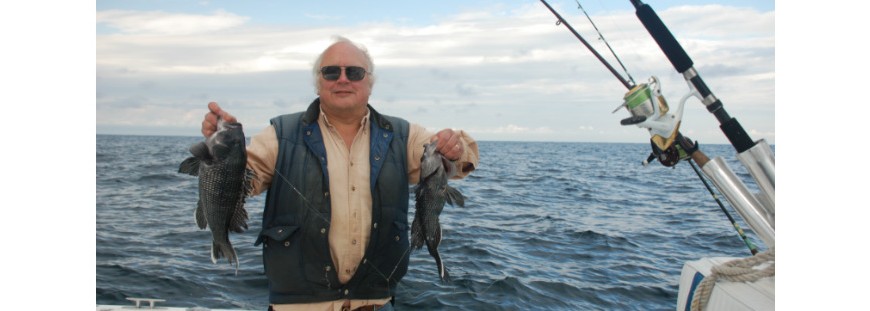Top photo: Charles Witek with black sea bass
Since March 2019, the Mid-Atlantic Fishery Management Council (Council), in conjunction with the Atlantic States Marine Fisheries Commission’s (ASMFC) Summer Flounder, Scup, and Black Sea Bass Management Board (Management Board) have been quietly working on changing the way that some recreational fisheries are managed.
The reform initiative was initially intended to address only the recreational black sea bass fishery, but it quickly expanded to include summer flounder and scup as well. At its August meeting, the Management Board also considered including bluefish, and invited the ASMFC’s Bluefish Management Board (Bluefish Board) to collaborate on the matter.
In order to identify issues that should be considered in any reform process, the Council and Management Board created a Recreational Management Reform Steering Committee (Committee), composed of representatives from both such bodies, along with staff from the National Marine Fisheries Service’s Greater Atlantic Regional Fisheries Office, which has spent most of the past eighteen months contemplating what recreational reform might look like. It appears that the Committee may be nearing the end of its deliberations, and that the Council, Management Board and, probably, the Bluefish Board will soon start putting a draft management document together.
Will such recreational reform improve the fisheries management process?
The vision
The Committee has agreed on a vision intended to guide the development of any reform document, which it presents as
- Stability in recreational management measures (bag/size/season)
- Flexibility in the management process
- Access aligned with availability/stock status
None of those things, on their faces, are unreasonable proposals, but all could be problematic if improperly implemented.
Regulatory stability, for example, can benefit both anglers and the angling industry. If fishermen know what the regulations will be in the upcoming year, they can easily make travel plans for the next fishing season. Tackle shops have a better idea of how much inventory to order. Charter and party boats can better plan their seasons and begin booking trips, while fishing clubs, local chambers of commerce and other organizations can set tournament dates far enough in advance to better assure participation.
On the other hand, prioritizing stability over the health of fish stocks can lead to managers taking no action to address problems with a stock until such problems become severe. The ASMFC’s failure to intervene when the striped bass stock began to decline, allowing the stock to become overfished, demonstrates the consequences of management inaction.
Because regulations now frequently change from year to year, based on estimates of recreational landings, changes in fish abundance and similar factors, neither anglers nor angling-related businesses regularly enjoy the benefits that stability can bring. Thus, the Committee suggested some objectives that might promote recreational stability and its ensuing benefits, as well as advance the other aspects of the Committee’s vision.
The objectives
The first such objective was to “Better incorporate uncertainty in the [Marine Recreational Information Program (MRIP)] data into the management process.” That’s a reasonable goal, as MRIP data does vary from year to year, particularly when used at a state, seasonal, or sector level. Sometimes, particularly when used at such levels, MRIP data will produce an estimate that seems very improbable, and can be viewed as an outlier that is unlikely to reflect actual landings levels. The Committee suggests developing a process that could use recognized statistical methods to “smooth” estimates that seemed incongruously high or low.
Such an approach would almost certainly enhance the overall quality of MRIP data.
Another possible approach would recognize that some uncertainty always surrounds recreational catch, landings, and effort data, which MRIP expresses as a “percent standard error” (PSE). The Committee suggested that if the recreational harvest limit for any given year falls within the PSE for the previous year’s landings, then the previous year’s recreational regulations could remain in force.
That, too, is a statistically justifiable approach to regulatory stability.
And because fisheries managers must try to set the upcoming year’s regulations before the current year has ended, making it impossible to fully know the magnitude of the current year’s landings, the Committee suggested that managers give greater consideration to when the use of preliminary landings estimates, usually based on landings for the first eight months of the year, are appropriate, and whether they should be supplemented by an additional information.
That is a question that fisheries managers have been wrestling with for a while, and certainly deserves further thought.
The Committee’s second objective was to “Develop guidelines for maintaining status quo measures.”
Such objective obviously supports the desire for regulatory stability. Currently, management measures are generally set by comparing landings estimates with the recreational harvest limit (RHL); if the landings are above the RHL, more restrictive measures are imposed, but if the landings are below the RHL, regulations are often relaxed.
The Committee suggested a more nuanced approach, that would consider not only the relationship between landings and the RHL, but also the biomass of the stock, fishing mortality levels, and the recruitment of new fish into the population when deciding whether regulations ought to be changed.
Such an approach could certainly provide benefits. As the Committee noted, “poor or declining stock status indicators could require changes when status quo would otherwise be preferred.” However, managers could also argue for the opposite effect, using supposedly positive information to argue for status quo regulations when landings significantly exceeded the RHL.
There is also the question of who would be empowered to interpret the biological data. Under the current system, prescribed in the Magnuson-Stevens Fishery Conservation and Management Act (Magnuson-Stevens) the Council maintains a Scientific and Statistical Committee, composed of trained scientists, who set the acceptable biological catch (ABC), from which the RHL is derived. If the Council, Management Board and/or Bluefish Board base regulations on MRIP estimates and the RHL, they’re standing on a solid statistical and scientific base.
However, if the people sitting on those management bodies, the majority of whom are not trained scientists, are permitted to make their own interpretation of the scientific data, and use that interpretation to decide whether maintaining status quo regulations is justified, even if such regulations caused recreational landings to significantly exceed the RHL, the management process will be skating dangerously close to managing by laypersons’ opinions, rather than by scientific advice.
That would be a bad direction to take, although at the Council, the situation couldn’t grow too dire, for the mandates of Magnuson-Stevens would still apply; the Council would not be allowed to adopt or maintain any management measure that is likely to cause overfishing. But no such constraint would bind the ASMFC.
Thus, this objective, if implemented badly, could increase the risk to fish stocks.
The Committee’s third objective, “Develop process for setting multi-year recreational management measures,” also incorporates a significant level of risk, as it calls for “a commitment to making no changes in the interim year,” even if there is “new data that would otherwise allow for liberalization or require restrictions.”
While foregoing liberalization would do no harm to the stock, taking no action if new information indicated that the stock is declining or experiencing excessive fishing mortality could cause further damage to the resource. While this objective, like the one described above, would be constrained at the Council level by the language of Magnuson-Stevens, the reluctance to take action in the face of adverse data is still worrying.
If the need to maintain stable regulations over a period of years is, in fact, so compelling, managers could better assure stability by setting relatively conservative RHLs that have a high probability of preventing overfishing, so that if such RHLs were exceeded, overfishing still would not occur. But when one considers the Committee’s vision also calls for “accessibility,” that is not likely to be a palatable approach.
The Committee’s final two objectives, “Consider improvements in the process used to make changes to state and federal recreational management measures” and “Consider making recommendations for federal waters recreational measures earlier in the year,” were not as fully fleshed out as the other three, and probably have lesser implications for the health of fish stocks.
Some of the topics associated with the latter objective, improving the process of changing regulations, including establishing guidelines for using MRIP data at a state, seasonal, or sector level, when such data is significantly less accurate than it is when used to derive coastwide estimates, certainly deserve a deeper look. On the other hand, suggestions that managers consider data other than that supplied by MRIP as part of the regulatory process could well increase management uncertainty, unless such data was derived using a statistically valid methodology that had successfully passed through the peer review process.
The final option, implementing federal regulatory changes earlier in the year, perhaps in August or October rather than in December, would bring both costs and benefits.
The federal rulemaking process imposes strict timelines for the rulemaking process; although the fishing season for summer flounder, scup, black sea bass, and bluefish begins on January 1, and anglers usually presume that any new regulations are in effect by that time, that is usually not the case. Because of the requirements established by the federal Administrative Procedures Act, such measures don’t typically become enforceable until April or May. Allowing the Council to adopt such measures as early as August would allow regulations to be in place at or near the start of the fishing year.
Early adoption of regulations would also allow businesses more lead time to order merchandise, book trips, and prepare better business plans for the upcoming year.
On the other hand, such early adoption would mean that regulations would, at best, be based on recreational catch, effort and landings estimates through June 30, and provide managers with no idea of what was caught in July and August, when most fishing activity for the species in question occurs. That would add considerable uncertainty to the management process.
Thus, the vision and objectives established by the Committee are a mixture of good and potentially problematic points. Because the Council could not override the express provisions of Magnuson-Stevens with respect to overfishing, rebuilding overfished stocks, establishing annual catch limits, and employing the best science available, the downside of such recommendations is limited. At the same time, the potential improvements to the management system could be very real.
Putting people first, fish last
The recreational reform process becomes problematic when suggestions and discussions that focus on the issue of “accessibility” which, for practical purposes, means allowing anglers to harvest more fish than they currently may.
The worst of those suggestions harkens back to the debate over the so-called “Modern Fish Act,” and the use of “alternative management measures” rather than poundage-based annual catch limits to manage recreational landings. The same organizations that spearheaded the fight for the Modern Fish Act are now proposing a “control rule” to replace management measures keyed to expected landings and the RHL.
Such proposed control rule would create a series of “steps” corresponding to levels of stock abundance. Management measures, including size limits, bag limits, and seasons, would be preset, supposedly to correspond to the status of the stock, becoming more restrictive as biomass approached, and then dropped below, the biomass threshold. No annual catch limit would apply.
The argument made in support of that approach makes little sense, and seems mired in circular logic. The organizations aver that “access (allocation) can be defined for the recreational sector as a combination of size limits, bag limits and seasons, instead of a pound-based quota. This is directly relatable to commercial quota in pounds because access is less or more restrictive based on stock conditions through changes to quota (commercial allocation) and management measures (recreational allocation).”
The argument that the proposed control rule is “directly relatable to commercial quota in pounds,” never addresses why a recreational quota in pounds isn’t equally, or even more, relatable to the commercial quota. Instead, while commercial fishermen are subject to accountability measures, usually in the form of pound-for-pound paybacks in a future year, under the proposed control rule, anglers would apparently face no consequences for harvesting more fish than the stocks can safely sustain.
The justification for that seems to be that “Defining access in pounds does not work for the recreational sector because recreational anglers have no control over the harvest estimates that are generated when they follow established management measures. Choosing to reallocate based on revisions to catch data has the potential to result in continuous allocation changes…”
There was more written, but that’s probably enough to demonstrate what’s happening here, and none of it makes too much sense. What does “recreational anglers have no control over the harvest estimates…when they follow established management measures” even mean?
Recreational anglers do have control over what they harvest, which is what the harvest estimates measure, and the entire point of the management process is to revise management measures if they allow fishermen, including recreational fishermen, to land too many fish each year. The control rule proponents are trying to present those facts in a way that somehow makes it seem wrong to rein in recreational overharvest.
And there are no “continuous allocation changes.” Allocations are set in the various management plans, which currently allocate 40 percent of the summer flounder, 21 percent of the scup, and 51 percent of the black sea bass to the recreational sector. That doesn’t change from year to year. Those quotas are based on an overall annual catch limit intended to prevent overfishing, which catch limit is then divided between the commercial and recreational sectors. If both sectors stay within their quotas, and their respective allocations, the stock should remain healthy in the long term.
The problem is that anglers often don’t stay within their allocations, but instead exceed their RHLs by a significant amount. Regulations must then be changed in order to reduce recreational landings, hopefully to or below the RHL.
That has nothing to do with changing the allocation. It has everything to do with trying to keep anglers from exceeding their quota, and from potentially threatening the health of the stock. The control rule’s proponents are thus trying to perpetuate recreational overharvest, avoid recreational accountability, and place short-term landings, and any potential economic benefits that may ensure, ahead of the health of the stock.
Unfortunately, the proposal is still a part of the recreational reform debate. It was discussed in some detail at the Management Board’s August meeting, when we learned that the standard for regulations at the highest level of stock abundance would be the “most liberal set of measures preferred by anglers when biomass is high,” while the standard for an overfished stock would be the “most restrictive measures that could be tolerated without major loss of business.”
Management measures adopted because they are “preferred by anglers” or “tolerated without major loss of business,” rather than management measures directly tied to the needs of fish stocks, would represent a major step backward for federal fishery management.
Fortunately, the worst of their impacts would, again, probably be blocked by the clear language of Magnuson-Stevens. Yet we can still expect to see the national angling organizations, and the angling industry, pushing hard for their adoption.
That demonstrates just why maintaining a strong Magnuson-Stevens, and making the law even stronger in important respects, is necessary if we intend to keep the nation’s fish stocks abundant and healthy well into the future.


